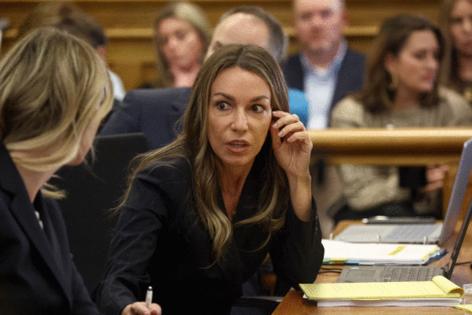Karen Read trial Day 2: John O'Keefe's mother testifies as defense sets stage for conspiracy
Published in News & Features
DEDHAM, Mass. — A key witness in the defense’s theory of a conspiracy to frame Karen Read is all over the retrial before she’s even been called.
Jennifer McCabe was the focus of one of the most hotly contested factors in the first trial, and if Wednesday’s continuing testimony from her friend Kerry Roberts is any indication, McCabe will again be central to their theory of a local conspiracy to frame a Canton outsider: Mansfield’s Read.
Roberts under cross-examination admitted that she had spoken to McCabe as recently as that morning, though she said they didn’t talk testimony and instead McCabe wished her good luck in court. The pair have grown very close, Roberts testified, since finding, along with Read, O’Keefe dead or dying on the front lawn of 34 Fairview Road in Canton.
“I spoke with many people who I grew up with,” Roberts said in court in defense of her speaking with McCabe as a supportive friend. “And Jen especially. We went through a very traumatic experience together.”
Read, 45, of Mansfield, faces charges of second-degree murder, manslaughter while operating a motor vehicle under the influence, and leaving the scene of an accident causing death.
Prosecutors say that Read backed her Lexus SUV into O’Keefe at up to 24 mph in the early morning hours of Jan. 29, 2022, leaving him to freeze and die on the front lawn of 34 Fairview Road in Canton. She was tried last year but that ended in mistrial.
Defense attorney Alan Jackson in his cross-examination hammered away at Roberts’ memory of the night the trio were together in search of O’Keefe, getting her to admit to at least a “faulty” memory of when Read might have pointed at her damaged taillight and asking if she may have hit O’Keefe.
But it’s more than a faulty memory, Jackson posited through his questioning. Instead, he suggested that Roberts was under McCabe’s spell and that the new friend was “influencing” Roberts’ memory.
Roberts had testified to the grand jury — which is a stage that came before Read’s indictment — that she had heard Read ask McCabe to “Google hypothermia.” It turns out that Roberts had never heard Read say that but had come to the conclusion that she had based on a “timeline” that Roberts and McCabe had worked out. Roberts said that she misunderstood the question.
While that bit of information may not make too much sense to the nine women and nine men of the jury now, it’s the first piece of the puzzle making up the defense’s theory of a frame job. The McCabe part of the picture is her Google search for “hos (how) long to die in cold” and when that search was performed.
McCabe, and Roberts, say that Read asked her to make the search as they sat in a car near where O’Keefe lay. But a defense forensic expert says that the search was instead made at 2:24 a.m. — hours before O’Keefe was supposed to have been discovered and thus indicating prior knowledge of his fate.
The hospital and the mother
Roberts, who testified she had been a longtime friend of O’Keefe’s, got emotional as she described seeing him in his room at Brockton’s Good Samaritan Hospital later that morning.
“John was in a neck brace at this time, there was a trail of blood … this time both eyes were filled with blood, he had raccoon eyes,” she said. “The right eye was out to here,” she continued, “like a golf ball.”
But the emotions really came out when O’Keefe’s mother, Peggy O’Keefe, took the stand. Special prosecutor Hank Brennan had to offer her tissues and moments to collect herself as she testified to her own trip to the hospital with her husband, John O’Keefe Sr., and Roberts.
It began with a call from Roberts: “She said, ‘Found him in the snow, we don’t know what happened.’”
At the hospital, Peggy O’Keefe said, she was walking down the corridor to her son’s room when she saw Read. Read called out to her: “Peg, is John dead?!” Peggy O’Keefe said she didn’t respond, but asked a nurse “What is she doing here?”
It wasn’t her only interaction with the defendant. She said that she spoke with Read on the phone during the ride over: “She said ‘We went to a party and I left him there.’ I said, ‘You just left him there?’ She said, ‘I just left him there.’”
The interactions between the pair were the subject of two Read media interview clips that Brennan wanted to show the jury. One, which Cannone said she wants to think about and will rule on admissibility in the morning, had Read say — during the recent ID/(HBO) MAX documentary “A Body in the Snow” — that Peggy O’Keefe accused her of wrongdoing.
“His mother leans over the kitchen island and says to me, ‘I think he looks like he got hit by a car. He looks like he got hit by a car,” Read says in the clip.
Brennan said that the clip would indicate consciousness of guilt.
Jackson said the argument was “baffling” and that Read was just retelling something she believed she heard — though Peggy O’Keefe testified they had no such exchange.
“Playing this video is just wanting to vilify my client because of the tone of voice she used,” he said, arguing that asking to read a transcript instead would be different. “That’s prejudicial.”
Brennan countered that “The defendant should not be able to pick and choose which of her statements do not look good for her and do not look bad for her.”
The other clip also had to do with the exchange, and Cannone allowed it to be played to jurors. Jackson said that he had no objection because he disagreed that the clip displayed consciousness of guilt, “the opposite, really.”
Other witnesses
Canton Fire paramedic Daniel Whitley testified that he took Read to the hospital on a “Section 12,” which is a law enforcement-directed psychological assessment.
Whitely, who said he was “acquaintances” with Roberts, arrived on the scene after O’Keefe had been transported to the hospital. He said Read came willingly with him and that she was crying and asking if someone could survive hours in the cold without a coat. He said he tried to comfort her and told her it looks like she has a good support system.
Read then raised her eyes from crying in her hands, he testified, and asked if he knew Roberts. He said that he did. She said that anyone who knows Roberts wouldn’t describe her that way then rolled her eyes. He called the behavior “bizarre,” but after an objection, Cannone had it stricken from the record.
In cross-examination, defense attorney David Yannetti also set the stage for the cover-up conspiracy. He asked Whitely whether, in all the commotion of emergency vehicles and personnel, the homeowner, Brian Albert — who the defense has named as a possible third-party killer — ever came out of the house. Whitley said that he was focused on Read and not the house so he doesn’t know.
Yannetti also challenged Whitley’s prior testimony that Read seemed “snarky.”
The second witness of the three called Wednesday was Massachusetts State Police Trooper Nicholas Guarino, who did the “extractions” of the phones of Read and John O’Keefe. Another member of the MSP digital forensics unit at the Norfolk District Attorney’s office extracted Roberts’ phone.
Guarino’s testimony was largely limited to a description of the process involved; he wasn’t involved in the case apart from his digital forensics expertise. Brennan said he wants to recall him later in the trial.
_____
©2025 MediaNews Group, Inc. Visit at bostonherald.com. Distributed by Tribune Content Agency, LLC.







Comments